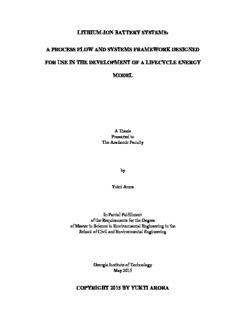Table Of ContentLITHIUM-ION BATTERY SYSTEMS:
A PROCESS FLOW AND SYSTEMS FRAMEWORK DESIGNED
FOR USE IN THE DEVELOPMENT OF A LIFECYCLE ENERGY
MODEL
A Thesis
Presented to
The Academic Faculty
by
Yukti Arora
In Partial Fulfillment
of the Requirements for the Degree
of Master in Science in Environmental Engineering in the
School of Civil and Environmental Engineering
Georgia Institute of Technology
May 2015
COPYRIGHT 2015 BY YUKTI ARORA
LITHIUM-ION BATTERY SYSTEMS:
A PROCESS FLOW AND SYSTEMS FRAMEWORK DESIGNED
FOR USE IN THE DEVELOPMENT OF A LIFECYCLE ENERGY
MODEL
Approved by:
Dr. Randall Guensler, Advisor
School of Civil and Environmental Engineering
Georgia Institute of Technology
Dr. James Mulholland
School of Civil and Environmental Engineering
Georgia Institute of Technology
Dr. Mike Rodgers
School of Civil and Environmental Engineering
Georgia Institute of Technology
Date Approved: November 25, 2014
ACKNOWLEDGEMENTS
I wish to thank my mother, my advisor, faculty, and friends who continually
showed support while I vigorously finished this thesis.
iii
TABLE OF CONTENTS
ACKNOWLEDGEMENTS iii
LIST OF TABLES viii
LIST OF FIGURES ix
LIST OF ACRONYMS x
1. INTRODUCTION 1
2. BACKGROUND 5
3. LITERATURE REVIEW 9
3.1 Types and Configuration of Electric Vehicles 9
3.1.1 All-Electric Vehicles 9
3.1.2 Hybrid-Electric Vehicles 12
3.1.3 Plug-in Hybrid Electric Vehicles 13
3.2 Different Types of Li-Ion Battery Systems and their Advantages and
Disadvantages 17
3.3 Battery Structure 21
3.3.1 Cathode 21
3.3.2 Anode 23
3.3.3 Electrolyte 24
3.3.4 Separator 24
3.4 Mechanics of Batteries 25
3.4.1 Safety 27
3.4.2 Challenges and Future Research 27
3.5 Key Lithium-ion Battery Players 28
3.6 Lithium Resource Base 30
3.6.1 Uses of Lithium 30
3.6.2 Sources of Lithium Deposit 31
3.6.2.1 Continental Brine 32
iv
3.6.2.2 Geothermal Brine 32
3.6.2.3 Oilfields 33
3.6.3 Rocks 35
3.6.3.1 Pegmatite or “Hard Rock” 35
3.6.3.2 Spodumene 36
3.6.3.3 Clay Deposits 36
3.6.3.4 Lacustrine Evaporites 37
3.7 Lithium Global Reserves 40
3.7.1 Latin America 42
3.7.1.1 Chile 42
3.7.1.2 Argentina 43
3.7.1.3 Bolivia 44
3.7.2 United States (U.S.) 44
3.7.3 Canada 46
3.7.4 China 46
3.7.5 Russia 47
3.7.6 Australia 48
3.8 End of Life-Recycling 48
3.8.1 Umicore V’al eas Process 49
3.8.2 The Toxco Process 50
4. LITHIUM-ION SYSTEMS FRAMEWORK 53
4.1 Mining/Extraction 53
4.1.1 Resource Extraction 54
4.1.2 Evaporation 54
4.1.3 Purified or Refined Lithium 54
4.2 Battery Production and Assembly 57
4.2.1 Battery Cell Materials 57
v
4.2.2 Battery Cell Fabrication and Production 58
4.2.3 Battery Final Pack Assembly 58
4.3 Vehicle Manufacturing 60
4.3.1 Installation 60
4.3.2 Warehouse Storage 61
4.3.3 Dealership 61
4.4 Consumers 62
4.4.1 Service Station 63
4.5 End of Life 65
4.5.1 Landfill 65
4.5.2 Third Party Recycling 66
4.5.3 Hazardous Waste Site 66
5. A PROPOSED LITHIUM LIFECYCLE ASSESSMENT MODEL 70
5.1 Resource Extraction Module 71
5.1.1 Brines 71
5.1.2 Mining and Processing Operation 72
5.1.2.1 Machinery and Equipment 73
5.1.2.2 Products 73
5.1.3 Transportation 74
5.2 Battery Production and Assembly Module 76
5.3 Vehicle Manufacturing Module 77
5.4 Consumer Module 79
5.5 End of Life Module 80
5.5.1 Landfill 80
5.5.2 Third Party Recycling 81
5.5.3 Hazardous Waste Processes 81
6. CONCLUSION 83
vi
REFERENCES 86
vii
LIST OF TABLES
Table 1 Performance Characteristics of Li-ion Batteries in EV, HEV, and PHEV (Lowe,
et al., 2010) ..........................................................................................................7
Table 2: Overview of Four Battery Technologies and Limitations for Hybrid Vehicles .. 20
Table 3: Input and Output Quantities from Brine and Hard-Rock Process ...................... 74
Table 4: Input and Output Quantities from Battery Manufacturing Module .................... 77
Table 5: Input and Output Quantities from Vehicle Manufacturing Module ................... 79
Table 6: Input and Output Quantities from Consumer Module ....................................... 80
Table 7: Input and Output Quantities from End of Life Module ..................................... 82
viii
LIST OF FIGURES
Figure 1: HEV Components ........................................................................................... 13
Figure 2: Series Hybrid Drivetrain (Martin, et al., 2014) ............................................... 15
Figure 3: Parallel Hybrid Drivetrain (Martin, et al., 2014) ............................................. 16
Figure 4: Power-Split (Series-Parallel) Hybrid Drivetrain (Martin, et al., 2014) ............ 16
Figure 5: Pros and Cons of four Different Battery Chemistries....................................... 23
Figure 6: Li-ion Battery Charge Cycle (Brain, 2006) ..................................................... 26
Figure 7: Li-ion Battery Discharge Cycle (Brain, 2006) ................................................. 26
Figure 8: Global Value Chain of Li-ion Batteries for Vehicles, with Major Global Players
and U.S. Players with Current and Planned Facilities (not exhaustive) (Lowe, et
al., 2010) ............................................................................................................ 29
Figure 9: Lithium Industrial Market Segments in 2013 .................................................. 31
Figure 10: Brine Basin Characteristics (Mohr, et al., 2012) ............................................ 34
Figure 11: Sources of Lithium Distribution (Evans, 2008) ............................................. 38
Figure 12: Flowchart of Lithium Resources, Reserves, Products, and Major Und-use
Applications. (Yaksic, et al., 2009)..................................................................... 39
Figure 13: Global Lithium Production in 2013 ............................................................... 40
Figure 14: 2010 Global Lithium Reserves (tons) ........................................................... 41
Figure 15: Brine Basin Information (Mohr, et al., 2012) ................................................ 41
Figure 16: Lithium Brines in the Lithium Triangle (Robles, 2013) ................................. 42
Figure 17: Partial Cation Chemical Analyses (weight%) of Brines in US, Chile, Bolivia
(Kunasz, 2006) ................................................................................................... 45
Figure 18: Process Flow Chart for Umicor’s Val’Eas Recycling Process for Lithium-ion
Batteries (Cheret, et al., 2007; Vadenbo, 2009) .................................................. 50
Figure 19: Process Flow Chart for Toxco’s Recycling Process for Lithium-ion Batteries
(Cheret, et al., 2007; Vadenbo, 2009) ................................................................. 52
Figure 20: Mining/Extraction Portion of the Process Flow Model ................................. 56
Figure 21: Battery Production and Assembly Portion of the Process Flow Model ......... 59
Figure 22: Vehicle Manufacturing Portion of the Process Flow Diagram ...................... 62
ix
Figure 23: Consumer Portion of the Process Flow Diagram .......................................... 64
Figure 24: End of life/Recycling Portion of the Process Flow Diagram ......................... 67
Figure 25: A Complete Process Flow Model ................................................................. 69
x
Description:33. 3.6.3 Rocks. 35. 3.6.3.1 Pegmatite or “Hard Rock” .. future role of lithium battery recycling, and at what point in time establishing a recycling (2009), there is only enough capacity to meet the demand until 2050 without . optimum functionality and is generally measured as a state of char

